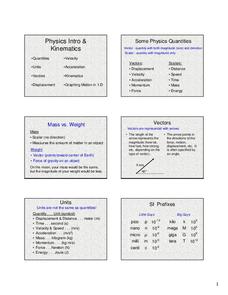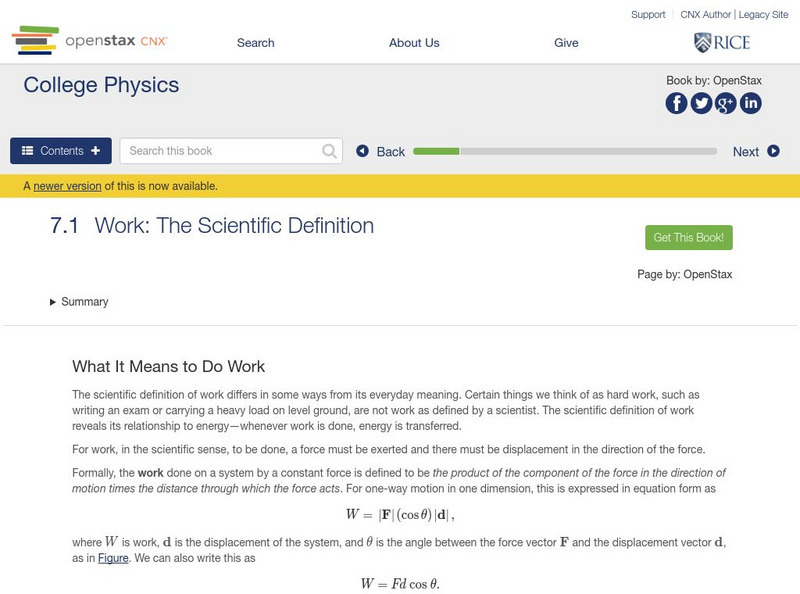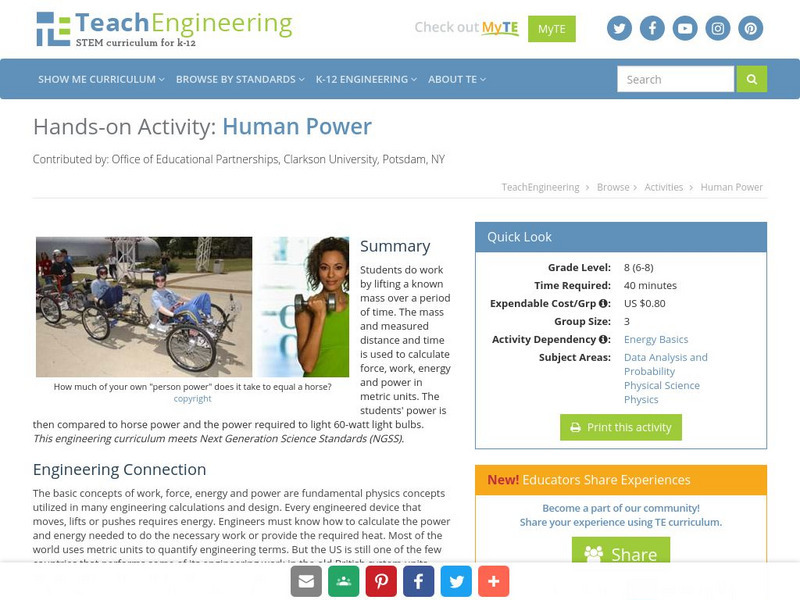Urbana School District
Physics Intro, Kinematics, Graphing
Some consider physics the branch of science concerned with using long and complicated formulas to describe how a ball rolls. This presentation, while long, is not complicated, yet it covers rolling, falling, and more. It compares vectors...
Curated OER
Fall 2005 Midterm Exam #1
You've got the power! With this physics midterm, you have the power to assess learners' grasp of electricity concepts. The exam is neatly formatted and provides a variety of question types: true or false, multiple choice, and problem...
Texas State Energy Conservation Office
Investigation: Conservation of Energy
By rolling marbles down a six-foot length of track, physical scientists determine how much energy is lost to heat. It is recommended that you opt for the foam pipe insulation track because more friction slows the marble, allowing...
Curated OER
Scientific Notation
Review conversion of decimal numbers into SN form with these examples of common astronomical applications and quantities. Young learners rewrite those numbers with scientific notation and with the correct units. The answers are available...
Cornell University
Splitting Water with Electricity
Explore how electricity splits water molecules into hydrogen and oxygen. Learners begin by calculating the voltage necessary to separate the water. They then perform the experiment and measure the ratio of hydrogen and oxygen bubbles.
Curated OER
Physics Rules and S.I. Units Game
In this physics rules worksheet, students complete questions and answers in order to review physics rules with each other. Students complete 26 questions.
Curated OER
Potential and Kinetic Energy
In this kinetic and potential energy worksheet, students read about energy of position and energy of motion and are given the equations to find each. Students match 11 terms with their definitions about both types of energy and the...
Curated OER
"Finding" Horsepower
Young scholars investigate horsepower as a unit of power. They examine history and discover that scientists and engineers of high achievement are considered to be among the most valued contributors to their culture.
Curated OER
Types of Circuits and Ohm's Law
In this circuits worksheet, students compare and contrast series and parallel circuits. Students learn about Ohm's Law and define current, voltage, and resistance. This worksheet has 6 matching, 18 fill in the blank, and 8 short answer...
Curated OER
Types of Circuits and Ohm's Law
For this circuits an Ohm's Law worksheet, students read about the differences between series and parallel circuits. They are given Ohm's Law and the definitions of current, voltage and resistance. Students match variables with their...
Curated OER
Solar Flare Reconstruction
In this solar flare reconstruction worksheet, students read about the 'saturation' point of satellite detectors when solar flares are at their most intense phase of brightness. Students are given x-ray flare data and they re-plot the...
Curated OER
Energy in a Clean Environment
Young scholars examine the efficiency of each alternative energy source as well as what limitations exist in terms of extracting the usable energy. They determine which energy source is most effective to the economy and the environment...
Curated OER
Bounce!
Students investigate the relationship between potential and kinetic energy. In this energy lesson plan students investigate the height a ball will bounce when dropped from various heights.
Curated OER
Eating your Energy's Worth
Students calculate the amount of electrical energy used in a week in food units. They create ways to reduce energy use. Students discuss the different forms and sources of energy. They discuss how people use electrical energy to power...
OpenStax
Open Stax: Work: The Scientific Definition
In the following interactive students will begin to explain how an object must be displaced for a force on it to do work. They will also explain how relative directions of force and displacement determine whether the work done is...
Sophia Learning
Sophia: Work: Lesson 2
This lesson will explain the concept of work, and show that it can be calculated using force and distance.
TED Talks
Ted: Ted Ed: How Does Work, Work?
In this video, Peter Bohacek explains the interplay between work and power and how it can be seen in the functioning of a clock. [4:31] Followed by a short quiz and a list of additional resources to explore.
University of California
University of California Los Angeles: Force, Work and Power
Describes the definition and relationships between force, work and power. Includes nice drawings to increase conceptual understanding.
National High Magnetic Field Laboratory
Magnet Academy: James Joule
James Prescott Joule experimented with engines, electricity and heat throughout his life. Joule's findings resulted in his development of the mechanical theory of heat and Joule's law, which quantitatively describes the rate at which...
Sophia Learning
Sophia: Sciences: Work
This resource gives the definition of work and explains how work is related to force and distance. Also explains the units used to measure work and how it is calculated.
TeachEngineering
Teach Engineering: Power, Work and the Waterwheel
Waterwheels are devices that generate power and do work. Students construct a waterwheel using two-liter bottles, dowel rods and index cards, and calculate the power created and work done by them.
TeachEngineering
Teach Engineering: Human Power
Students do work by lifting a known mass over a period of time. The mass and measured distance and time is used to calculate force, work, energy and power in metric units. The students' power is then compared to horse power and the power...
Famous Scientists
Famous Scientists: William Thomson
Learn about William Thompson's important work in the mathematical analysis of electricity and formulation of the first and second laws of thermodynamics, and did much to unify the emerging discipline of physics in its modern form.
























